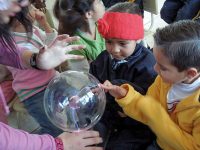
 Alfredo Menéndez Muros Alfredo Menéndez MurosAlfredo Menéndez-Navarro, Full Professor of History of Science at the University of Granada, carried out a research project about the risks of asbestos. |
||
|
Despite being banned in Spain since 2002, a five-year forecast (2016 –2020) anticipates one thousand deaths due to mesothelioma, a type of cancer caused by exposure to this material during the 70s, 80s and 90s. The estimation was made through a research project on the risk of asbestos, funded by the Ministry of Science and Innovation Department and carried out by Alfredo Menéndez-Navarro, Full Professor of History of Science at the University of Granada. With the contribution of epidemiologist Gonzalo López-Abente, the historian supports that even if it is true that a certain decrease on mortality rates is noticeable in the study «it is confirmed that until 2030 deaths linked to asbestos exposure in the 70s, 80s, and 90s will keep happening». These are some of the results shown by Alfredo Menéndez-Navarro in the conference «Asbestos: from Labour Problem to Environmental Risk, 1960-1980» that opened the seminar program of the López Piñero Institute of Science and Medicine History. According to the World Health Organization, around 125 million people are exposed to asbestos at work. In 2004, the same organization estimated at 107,000 the deaths caused by asbestos exposure at work. In the United Kingdom, according to the records, 3,500 deaths because of this problem happen every year. «Therefore, it still is a problem of our past, present and, unfortunately, future», said Menéndez-Navarro. A «Magical» Material Asbestos is an inexpensive group of fibrous fireproof materials. These features turned it into a «magical» material that was added to a great number of manufactured products and industrial processes. It was announced as a material for modern times, for progress. «The other side of the coin, inevitably, was that exposure to asbestos involves the burden of disease; essentially, respiratory and oncology diseases [interstitial lung disease and lung and mesothelium cancer]», noted Menéndez-Navarro. |
«According to the World Health Organization, around 125 million people are exposed to asbestos at work» |
|
 L. Sapiña L. SapiñaAlfredo Menéndez-Navarro during his conference, in which he explained how asbestos went from work to environmental risk during the Spanish transition to democracy. |
«Asbestos is still a problem of our past, present and, unfortunately, future» |
|
|
Up to the middle seventies there was no international consensus about the carcinogenic risks of asbestos. Once it was established that there were no safe exposure dosage for workers, the industry developed the strategy of creating scientific uncertainty. Thus, they claimed the problem was in blue asbestos and excluded the most widely used white asbestos. In Spain, international alarm about the carcinogenic risk of asbestos did not translate into specific studies by the administration or the companies of the sector. Influence studies were only carried out in provinces like Barcelona, with a high concentration of exposed people, or in sectors such as fibre-cement or naval engineering. These studies, given their design limitations, were not very influential. The province of Vizcaya saw a unique case. Doctor Luis López-Areal del Amo’s contribution was decisive to encourage recognition of asbestosis victims as work-related patients. From the Factory to the Street Despite the low impact of the issue in Spain, the situation changed in the mid-seventies, coinciding with the end of Franco’s regime and, according to Menéndez-Navarro, «with the weight trade unions ascribed to the problem of asbestos». The fight of the unions, inspired by the Italian labour movement, suggest global concern with risk factors. That way they extend the need to consider not just workers but their families and working circles. It is not a factory problem any more, it goes out into the streets. From the eighties, the media added the environmental aspect to labour risk. News analysed by Alfredo Menéndez-Navarro in newspapers such as ABC, El País and La Vanguardia or Interviú magazine «emphasize risks not only for workers, but for the rest of the population». The Unions’ bet for environmental aspects, together with media impact and the 1984 regulation about Risk Jobs with asbestos, decreases the workers’ risk due to exposure to the material. Despite all that, Menéndez-Navarro considers asbestos a «powerful social awareness agent concerning environmental impact of industrial activity». The video of the conference can be found on the MMedia website of the University of Valencia. Lucía Sapiña. The Two Cultures Observatory. Mètode, University of Valencia. |
«The industry developed the strategy of creating scientific uncertainty» |
|





